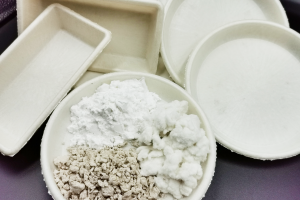Sustainable Biofoam Made from Cassava Starch and Natural Fibers: The Future of Eco-Packaging


Foam packaging is widely used for food products due to its low density, lightweight, strength, flexibility, and low cost. Typically, foam is made from polystyrene, a synthetic polymer that releases hazardous substances like styrene and benzene, both of which are carcinogenic. Additionally, polystyrene is non-biodegradable, contributing significantly to environmental pollution. To address this issue, starch from natural sources, such as cassava starch, has been explored as a substitute for polystyrene. However, cassava starch foam trays often exhibit poor properties as food packaging due to their low moisture resistance, as well as low strength and flexibility.
To overcome these limitations, biodegradable foam trays were developed using modified cassava starch treated with edible organic acids, which are safe for consumers, combined with natural fibers. This innovation improves the water resistance and mechanical properties of the foam, making it more suitable for use as packaging.
Output
The developed foam trays, made from modified cassava starch or cassava starch blended with natural fibers, exhibit mechanical properties comparable to commercially available starch-fiber composite foam trays. These trays retain their shape and stability when holding water at room temperature for 6-24 hours and hot water at 90°C for up to 30 minutes.
Applications
The biodegradable foam trays are suitable for use as packaging for fried foods or semi-dry food products, offering an environmentally friendly alternative to traditional foam packaging.
Research Funding
This research was funded by the Cassava Program under the Research Network for National Strategy (RNS) and the National Science and Technology Development Agency (NSTDA), Thailand.
